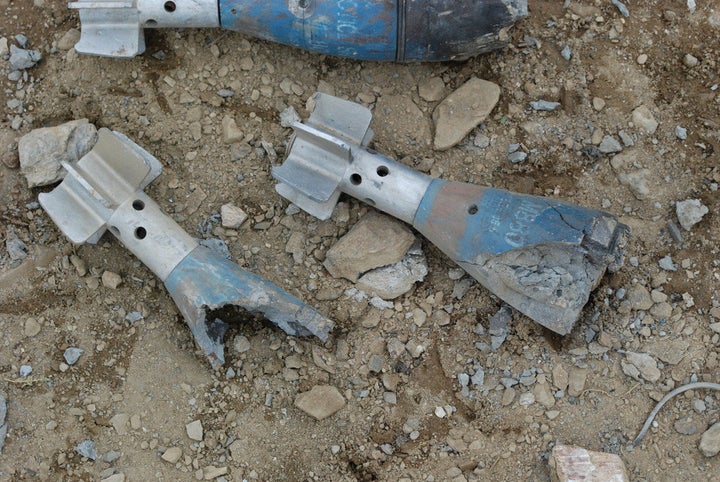
Watching Hollywood celebrate "The Artist" as last year's best picture on Sunday was reassuring and reminiscent of "The Hurt Locker's" win in 2010. Both films are refreshing evidence that the movie business is not always about catering to the least common denominator.
In fact, I was so moved by that prior Oscar winner that I traveled to Germany last summer to hang with real-life ordnance disposal workers. Unexploded bombs are still a big business in Germany: An estimated 10% to 15% of the two million tons dropped there during WWII never exploded.
"Here, put these gloves on first. We must have rules"
Ordnance expert Peter Ewler grinned, then allowed me to dip my hands into a bin of high explosives and lift out a 50-lb., unexploded shell. The rusted thing, from WWII, was of Russian origin and found near the Polish-German border. If my hand slipped, the concrete storage bunker we were in probably would go up.
In Brandenburg alone -- the place near Berlin I visited and the most infested of Germany's states -- around 350 tons of unexploded munitions are destroyed annually, including grenades, mortars, artillery shells, mines and aerial bombs. Some are found in fields, others in residential areas near homes and schools built after the war.
Wilfried Kramer, who oversees Brandenburg's War Ordnance Disposal Service, operates with an annual budget of 13 million euros, 8 million of which goes to private subcontractors, the rest to a staff of 66 field workers and technicians.
How do they find the bombs? Two-thirds are identified using old US and British air reconnaissance photos taken after bombing runs during the war. Telltale blips near large craters show where aerial bombs -- especially heavier ones -- may have landed but never exploded. The most dangerous were set to detonate hours after landing to create prolonged chaos. Problem is, many landed in the wrong position for the "long-delay" fuses to work properly, and are still live.
Heino Borchert is responsible for Oranienburg, a particularly problematic area. Because the Allies thought Nazis were developing nuclear bomb parts there, raids by US and British aircraft blasted the place. The theory was that even if Germany didn't complete an atomic bomb, Russia might capture the area before the Allies and acquire the technology.
Borchert took me to a residential area with unexploded bombs still in the ground. One 550-lb. and two 1,100-lb. US monsters had already been found and detonated. Large craters filled with water marked the holes. But two more nearby are still being hunted. I walked over and stood on a site full of grey plastic pipe probes, knowing something that could take out half a city block likely lurked 25 feet below me. It was unsettling, and within a stone's throw of nearby houses!
When a bomb is judged stable enough for transport, it is brought to a central munitions complex in Kummersdorf. Some dismantling is still done there by hand, but more often now detonator and fuse removal is achieved using remote-controlled saws. We watched on video camera from a separate control room as a Russian grenade was successfully sliced in half.
When enough ordnance accumulates (35 tons), the facility stages detonations. Guido Kuschinsky, who runs Kummersdorf, says his wife is always worried and "makes me call after every detonation." Despite bravery, these guys don't show up on rich lists. The average senior "fire worker" earns 30,000 euros annually.
Kuschinsky led me to a concrete bunker where the live bombs are stored. First I signed a paper releasing authorities from liability should one explode. Kuschinsky told of a friend he lost in this very room when a small device went off. Asked if he has had close calls himself, he shook his head, said he didn't want to talk about it.
For the last part of my trip, I drove to the Polish border to meet with Ewler, who was waiting in a grassy field near the Oder River. One of his workers was busy surveying the ground with a metal detector. Suddenly he stopped and began digging--carefully. Sure enough, a few feet below a small rusted device was visible. Ewler pointed out that the fuse was missing but not the detonator, making it unstable for transport.
A plastic explosive was buried along with the mortar shell. We retreated 275 yards. After a short countdown, a radio sent the signal. In a magnificent show, the shell--along with other ordnance found earlier--shot earth and smoke 100 feet into the air. I finally began to feel like Jeremy Renner in the "The Hurt Locker." But when Ewler, 47, told me he lost three friends in 2010 when a 1,100-lb. bomb blew in Gottingen, I quickly realized this wasn't Hollywood.
Even though WWII is 67 years gone, it's never over for these fire workers. As technology improves, so do methods for bomb detection. While thousands have been found, many more lie in wait. And the longer they wait, the more dangerous they become. TNT never decays, but the stabilizing agent in the explosive does. Left to their own devices, the bombs eventually explode.
It's happening already. Phosphorous ordnance will ignite spontaneously, causing wildfires. Fire departments sometimes won't go in for fear of other bombs exploding, too. Germany is still at war -- but this one is with time.